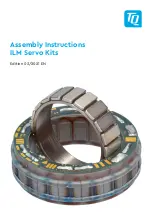
Mach-DSP User’s Manual
Document Number: MACH-DSP-9021
Page 51
www.ScannerMAX.com
Input clipping and shaping
In this section, you will find the parameters related to the input command signal.
Slew rate for positive movements
(degrees per millisecond)
This controls the slew rate limiter for scanner motion that corresponds to signals having
a rising slope. If you experience overshoots on very large step inputs but small step
inputs are well controlled, then the slew rate limiter may be used (or may be used in
conjunction with the error signal modifier) to eliminate overshoots on such large-step
inputs. (Note that if this is set to zero, then the slew rate limiter is completely disabled.)
Slew rate for negative movements
(degrees per millisecond)
This controls the slew rate limiter for scanner motion that corresponds to signals having
a falling slope. Although typically this would be set to the same number as the “Slew
rate for positive movements”, the slew rate limiter in the Mach-DSP servo driver allows
separate values for positive and negative slopes, for special applications.
Slew rate enhancement
(positive for logarithmic; negative for linear enhancement)
A conventional slew rate limiter is well known to control overshoots, but is also known to
impose a speed penalty on scanning, because the rate-of-change-of-command is
effectively limited to a pure triangle-function. To provide better performance, the Mach-
DSP includes a “Slew rate enhancement”, which allows the slew to
accelerate
either
logarithmically (if it is set to a positive number) or linearly (if it is set to a negative
number) based on input amplitude. The ultimate benefit is the elimination of overshoots
while minimizing the speed penalty normally associated with a slew rate limiter.
Input and Position Resolution Enhancement
The Mach-DSP includes the ability to successively average several samples, thereby
effectively increasing the resolution of the Command and Position signals. (To learn
more about
how averaging several samples can effectively increase ADC resolution
,
search the Internet using the underlined/highlighted text above.) Selecting enhanced
resolution can reduce the quantization noise of the analog-to-digital converters on the
Mach-DSP (as well as other external noise sources) and thus decrease dithering of
static mirror positions. However, this comes at the cost of reducing command signal
bandwidth and increasing tracking error (also known as tracking delay). Nevertheless, if
dither and noise are greater priorities than bandwidth and tracking error, this feature
may be helpful. Moreover, since this feature allows user-selectable averaging of
anywhere between 2 samples (for 0.5 bit resolution enhancement) and 4 samples (for
1.0 bit resolution enhancement), you can try different resolution enhancements to
balance the tradeoff between dither/noise reduction and bandwidth/tracking error. Note
that the damping parameters will need to be adjusted when this value is changed. Also
note that if
Input Shear
is not zero on both the X- and Y-axis, then you should use the
same
Input and Position Resolution Enhancement
setting for both X- and Y-axis.
















































